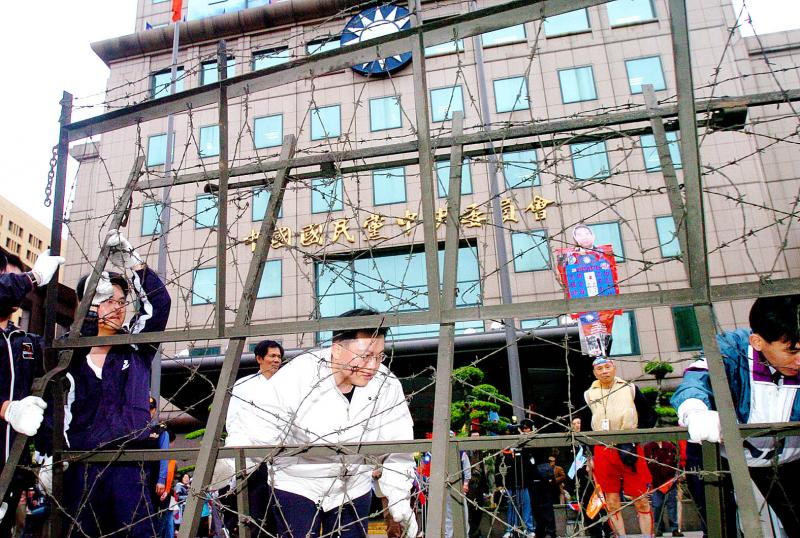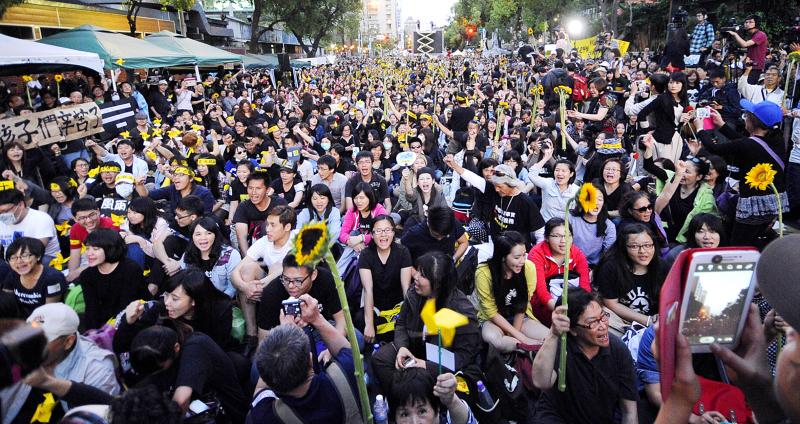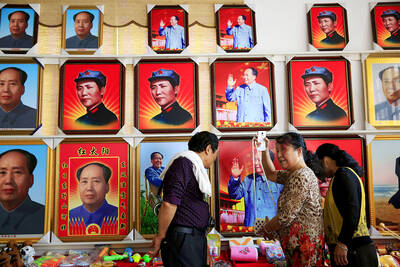Anyone viewing events in the US last week, with seditionist terrorists attacking and occupying the Capitol building, naturally might ask whether the same events could occur here in Taiwan.
As people are pointing out, in a way they already have. In 2004 after the election Chinese Nationalist Party (KMT) supporters, led by the losing presidential candidate Lien Chan (連戰), staged protests which became violent, while claiming numerous election irregularities, none of which were ever documented. Sit-ins were staged at courthouses across the nation, lingering for a week afterwards.
In 2000 after Chen Shui-bian (陳水扁) won for the first time, KMT supporters staged violent protests against then-president Lee Teng-hui (李登輝) in front of KMT headquarters. One of his advisors, Hsu Li-teh (徐立德), was dragged from his car and beaten. Lee was only able to leave party headquarters after riot police had cleared the street in front with water cannon.

Photo: Liu Hsin-te, Taipei Times
The quiet acceptance that accompanied the KMT’s more recent election losses shows that odds are against a violent putsch by rightists, at least from that quarter. Taiwan also has some advantages that the US does not, including structures for monitoring and neutralizing disinformation, much better social cohesion, a civic nationalism that incorporates democracy into the national identity and far more robust and fair election procedures.
There is no question that the potential is there. Afflicted with competing Chinese and Taiwanese nationalisms, Taiwan hosts a morass of conspiracy nonsense. There are long-running conspiracies about the 2004 assassination attempt on Chen, and on the conduct of the election itself, narrowly won by Chen. On the far right of the KMT there used to be people who argued that former president and KMT chairman Ma Ying-jeou (馬英九) was a closeted Taiwan independence supporter.
More recently, the claim that President Tsai Ing-wen’s (蔡英文) thesis is a fake, invented by deep greens impatient with her approach to independence, has found a populist home across the blue-green divide. Common conspiracy-style analyses, entirely bereft of any knowledge of history, that argue that democracy has been bad for the economy, society is in chaos and authoritarianism would make Taiwan great again are also popular, especially among men over 50.

Photo: Chen Tse-ming, Taipei Times
Like the equally mad conspiracy theories in the US, believers have incorporated them into their social identities and will not give them up no matter what evidence they are confronted with.
The potential is especially bad on the pro-KMT side, whose ideology of Chineseness and Lost Cause functions theologically to divide the world into good and evil. For the true believer in such theologies, defeat can only be the result of evil conspiracy, since how else could the good guys lose? Fortunately, at least on the blue side, most of the true believers are too old to engage in seditious violence against the government.
Taiwan also suffers from its own version of white racism — Han chauvinism — and a long history of ethnic rivalry. At present Han chauvinism lacks a well-organized overt politics and is largely directed against perceived outsiders such as foreigners, aborigines and migrant workers, not the government, while intermarriage and the emergence of a Taiwan-centered identity are slowly strangling Taiwan’s poisonous legacy of interethnic conflict.

Photo: Chen Chih-chu, Taipei Times
In Taiwan competent democratic governance has given the nation profound advantages. The governing administration can meaningfully act against disinformation and fake news. In last year’s election, the government worked with Facebook to combat disinformation and reduce its potential for polarizing society. Similarly, in November the National Communications Commission (NCC) rejected the license application of CTi News, forcing it to shut down, citing numerous citizen complaints about the station and fines for issues with its news presentations.
The US government has done nothing like that. Indeed, the administration of President Donald Trump has itself become a font of disinformation and fake news.
Further, the government’s practical successes with both the national health insurance program and against COVID-19 have created a deep sense of pride and social cohesion among locals. Local papers annually run articles on the National Health Insurance’s high global rank and high public satisfaction with the system.
Social cohesion is also fed by the deep yearning for international recognition among Taiwanese. Taiwan’s manifest economic and social successes, and its yearning for recognition, feed its democratic, post-independence identity which searches now for recognition as a competent, democratic, modern state. The existence of a very real threat from China not only increases social cohesion and the feeling of shared identity, but also legitimates government action against disinformation and in defense of a sovereign nation-state. Taiwan’s robust civil society with its active NGO ecology is also a powerful force for good.
Yet, we should be wary. Though social cohesion is strong, Taiwan faces long-term issues. There is a large working-class population struggling with stagnant incomes and long work hours (whose political function is to make dissent difficult due to lack of time and energy). Social media, especially Facebook but also WeChat and Line, have deep penetration in society, bringing with them all the problems of polarization and tribalization. Line groups are one of the most important transmission channels for disinformation, yet they remain under-researched. The nation’s north-south, rural-urban and west-east divides are also potential fracture points.
Taiwan also suffers from the problems fundamental to any modern society: the alienation and anomie that often mark modern urbanized populations, exacerbated by growing income inequality and regional wealth maldistribution. Small businesses, fiercely independent, are declining in importance.
Further, the country is a major participant in the system of globalized capitalist consumption in which everything that cannot be relentlessly commodified is discarded as waste. The world of marketing and advertising in this globalized worldscape is eerily like the world of populist nationalism: both are worlds in which things are constantly asserted that smart people know are false.
This globalized world brings globalized news and disinformation campaigns designed to split and polarize whole populations. Via cyberwarfare and social media platforms, nations exploit social weakness on a global stage.
Indeed, the social fracture lines driving racist populism are latent in the whole idea of the modern nation, there for anyone with wealth and power to exploit. The ethnicity-based nation-state bequeathed to the world by 19th century nationalism and Woodrow Wilson is inherently destabilizing and racist. Deep in its heart, this ideal assumes that humans who are different cannot live together in happiness and each group must have its own nation-state. In practice, it can be a recipe for endless atomization and marginalization of ethnic minorities at one end, and vast authoritarian empires on the other.
Let’s not forget: 10 years after the comical and failed Beer Hall Putsch, Hitler was running Germany.
Stay vigilant. Take it seriously. It can happen anywhere.
Long-time resident Michael Turton provides incisive commentary informed by three decades of living in and writing about Taiwan.

Taiwan can often feel woefully behind on global trends, from fashion to food, and influences can sometimes feel like the last on the metaphorical bandwagon. In the West, suddenly every burger is being smashed and honey has become “hot” and we’re all drinking orange wine. But it took a good while for a smash burger in Taipei to come across my radar. For the uninitiated, a smash burger is, well, a normal burger patty but smashed flat. Originally, I didn’t understand. Surely the best part of a burger is the thick patty with all the juiciness of the beef, the

The ultimate goal of the Chinese Communist Party (CCP) is the total and overwhelming domination of everything within the sphere of what it considers China and deems as theirs. All decision-making by the CCP must be understood through that lens. Any decision made is to entrench — or ideally expand that power. They are fiercely hostile to anything that weakens or compromises their control of “China.” By design, they will stop at nothing to ensure that there is no distinction between the CCP and the Chinese nation, people, culture, civilization, religion, economy, property, military or government — they are all subsidiary

Nov.10 to Nov.16 As he moved a large stone that had fallen from a truck near his field, 65-year-old Lin Yuan (林淵) felt a sudden urge. He fetched his tools and began to carve. The recently retired farmer had been feeling restless after a lifetime of hard labor in Yuchi Township (魚池), Nantou County. His first piece, Stone Fairy Maiden (石仙姑), completed in 1977, was reportedly a representation of his late wife. This version of how Lin began his late-life art career is recorded in Nantou County historian Teng Hsiang-yang’s (鄧相揚) 2009 biography of him. His expressive work eventually caught the attention

This year’s Miss Universe in Thailand has been marred by ugly drama, with allegations of an insult to a beauty queen’s intellect, a walkout by pageant contestants and a tearful tantrum by the host. More than 120 women from across the world have gathered in Thailand, vying to be crowned Miss Universe in a contest considered one of the “big four” of global beauty pageants. But the runup has been dominated by the off-stage antics of the coiffed contestants and their Thai hosts, escalating into a feminist firestorm drawing the attention of Mexico’s president. On Tuesday, Mexican delegate Fatima Bosch staged a